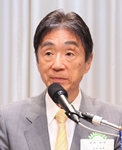Education at a Turning Point, Japan at a Turning Point
July 8, 2016
Dr. Yuichiro Anzai
President, Japan Society for the Promotion of Science
�� Please look at this chart showing the changes (1950s to 2030s) in the number of 18-year-olds and the proportion of how many of them advance to higher education. The number of this young age segment shows a sharp decline after 1993, which marks a turning point in the Japanese population that had increased steadily since the Meiji era. This decline has far-reaching impacts, especially over the educational fields.
Please look at this chart showing the changes (1950s to 2030s) in the number of 18-year-olds and the proportion of how many of them advance to higher education. The number of this young age segment shows a sharp decline after 1993, which marks a turning point in the Japanese population that had increased steadily since the Meiji era. This decline has far-reaching impacts, especially over the educational fields.
��We observed significant changes in the early 1990s, triggered by the fall of the Berlin Wall in 1989 and globalization that followed. The economic bubble burst in 1991 and the rapid spread of the internet and digital mobile gadgets from the mid-1990s have affected the society as a whole. Such major changes, in Japan and many other countries are coupled with a population decline in this country which is estimated to exacerbate from 2018.
��We are urged to address new educational needs against such backdrop to ensure every single child will be entitled to a truly fulfilling and happy life. Education is at a turning point, so is this country.
��Let me highlight that the number of university enrollments has remained relatively stable, regardless of the sharp decline in the 18-year-olds, which means the number of high-school graduate workers has decreased dramatically. There is a growing need for high-quality work worldwide, whereas Japan��s labor productivity is the lowest among the Group of Seven advanced economies. It is thus imperative to make university students more competent and to eventually make our workforce more competitive through educational reform.
��The timeframe for educational reform has set 1999, 2014, 2020 and 2024 as milestones to report on the deliberations of various councils. In 1999, a report was issued on how to link primary and secondary education to higher education. The Central Council for Education submitted a proposal in 2014 for integrated reform of high school and university education, which is scheduled to be launched full-scale in 2020. The reform will proceed by revising the national curriculum guidelines by 2024 to shift ��from passive education to active learning�� and to transform Japan into an education-oriented nation that fosters innovation.
��As the number of children will be halved by 2018, we must work towards maximizing each individual student��s potential to achieve his/her aspirations. Promoting the educational reform to make students learn on their own initiative will ensure future prosperity of Japan. Whether Japan manages to pass its turning point around 2020, when we host the Tokyo Olympics, depends on how far the educational system can be reformed.
��The results from the Programme for International Student Assessment (PISA) conducted by the OECD showed that the academic level of elementary and secondary school children in Japan ranked quite high in the world. When we look at high schools and universities in Japan, however, the levels and situation get diversified and complicated. As almost all students advance on to high schools, some are high-level prep school types while others have many truant students. After finishing secondary education, 330,000 students enter universities through general entrance exams today, while 270,000 students get accepted through AO exams or recommendation. 250,000 students enter technical schools and 200,000 start working. There are also students with special needs, including developmental disorders and learning disabilities. We have more than 1,000 universities and colleges across Japan that face various issues, including financial difficulties caused by the decrease in younger population as well as limited governmental funds allocated to higher education.
��Education aims to fulfill the potential of every single child, but it also forms the strategic basis of a nation. Countries around the world strive to overcome various issues and to improve their educational system towards training innovators and promoting active learning. Japan has set out to convert its educational system as part of a social reform, with the focus on higher and university education. The primary goal is to equip all students with sufficient knowledge and skills, while reinforcing the knowledge, intelligence and skill levels of top-level university students to make them more competitive in meeting the challenges of a globalized world. The second goal is to nurture the ability to think, decide and communicate to make students have strong command of one��s knowledge and skills, adapting to circumstances. The Central Council for Education suggested enhancing a self-directed attitude of learning where learners take initiative in cooperating with a range of people to identify issues and explore solutions. The Council is currently discussing how to revise the national curriculum guidelines in a comprehensive manner that ranges from changes in teaching methods, educational materials to students�� approach to learning.
��As I close my speech, let me call upon you to work together in the educational reform currently underway. I think many of you here have children or grandchildren who must live through a competitive future. Countries around the world put priority on education and Japan must not be left behind. Let us put our full strength into educational reforms to meet the challenges of the new era.